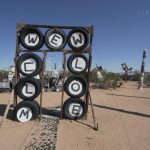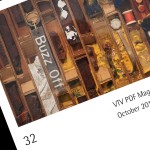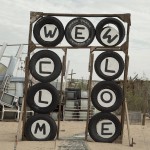Noah Purifoy: Junk Dada at the Los Angeles County Museum of Art (LACMA) is the first monographic exhibition dedicated to California-based artist Noah Purifoy since his passing in 2004. Noah Purifoy was an African American visual artist and sculptor, co-founder of the Watts Towers Art Center, and creator of the Noah Purifoy Outdoor Desert Art Museum. Purifoy was born in Snow Hill, Alabama in 1917. He lived and worked most of his life in Los Angeles and Joshua Tree, California. Noah Purifoy created an early body of sculpture out of the debris of the 1965 riots in the Watts district of Los Angeles. The resulting exhibition 66 Signs of Neon (1966) was shown at several venues between 1966 and 1969. Purifoy spent his final years in Joshua Tree where he created his greatest work, the Noah Purifoy Outdoor Desert Art Museum. On 7.5 acres of open land the museum displays assemblage sculptures and installations that Purifoy created between between 1989–2004.
This video provides you with an exhibition walkthrough, and an introduction to Noah Purifoy and his work by Franklin Sirmans, Co-curator of the exhibition. Noah Purifoy: Junk Dada was co-curated by Franklin Sirmans, Terri and Michael Smooke Department Head and Curator of Contemporary Art at LACMA, and Independent Curator Yael Lipschutz. The exhibition runs until September 27, 2015.
A video that shows how Noah Purifoy’s Outdoor Desert Art Museum looks like is coming soon.
Noah Purifoy: Junk Dada at the Los Angeles County Museum of Art (LACMA). Exhibition walkthrough and introduction by Franklin Sirmans, Los Angeles, September 8, 2015.
> Right-click (Mac: ctrl-click) this link to download Quicktime video file.
Info text:
Co-curated by Franklin Sirmans, Terri and Michael Smooke Department Head and Curator of Contemporary Art at LACMA, and Independent Curator Yael Lipschutz,
Noah Purifoy: Junk Dada examines the work of a seminal American artist who is still little known. Purifoy, a founding director of the Watts Towers Arts Center in Los Angeles, created an early body of sculpture constructed out of charred debris from the 1965 Watts rebellion. The resulting exhibition focusing on the riots, 66 Signs of Neon (1966), traveled to nine venues between 1966 and 1969. In line with his fascination with the street and its objects, Purifoy’s 66 Signs of Neon evoked a Duchampian approach to the fire-ravaged alleys of post-riot Watts with a peculiarly American spirit of making use of the material at hand. This strategy profoundly impacted artists such as John Outterbridge, Maren Hassinger, David Hammons, and Senga Nengudi, then emerging in Los Angeles and beyond. Purifoy dedicated himself to the found object and to using art as a tool for social change in the 20 years that followed the rebellion, after which he relocated to California’s Mojave Desert, where he spent his final 15 years creating large-scale installations.
“At the core of Purifoy’s lexicon is the desire to work with or find beauty in what has been discarded—to give new life to an object by changing its context, transforming it from junk to artwork,” says Sirmans.
Michael Govan, CEO and Wallis Annenberg Director of LACMA, states, “Purifoy’s assemblage resonates with early 20th-century European works in LACMA’s collection, such as Kurt Schwitters’s Construction for Noble Ladies and Marcel Duchamp’s With Hidden Noise, but imbues the practice with a distinctly American narrative of struggle, destruction, and rebirth.”
About the Exhibition
Noah Purifoy: Junk Dada is arranged in loose chronological order, with an emphasis placed on distinct stylistic periods of Purifoy’s career. The artist’s landmark exhibition 66 Signs of Neon is represented through approximately one dozen assemblage works by Purifoy and other artists, including Judson Powell, Debby Brewer, and Arthur Secunda. To Purifoy, the term assemblage referred to three-dimensional works that might serve as standalone sculptures (not as elements of an installation), and collage described two-dimensional works. Constructions were understood to be larger assemblages involving major elements of juxtaposed parts. Purifoy occasionally used the word combine to define both two-dimensional collages and three-dimensional assemblages, echoing a term coined by Robert Rauschenberg. Having developed this lexicon he continued to employ these diverse ways of working through the remainder of his career.
LACMA’s retrospective includes printed images from Purifoy’s 1971 solo exhibition at the Brockman Gallery. The artist referred to the provocative large-scale gallery installation depicting a single-room apartment inhabited by 11 family members as “environmental art.” Not long after this infamous exhibition, Purifoy withdrew from his art practice for over a decade, instead concentrating his energies on social work and as an arts advocate for the California Arts Council.
When Purifoy officially returned to art making in 1988, he began to incorporate discarded materials into his studio practice once again, prolifically adding 40 wall works to his oeuvre. In 1989, he relocated to Joshua Tree, where he spent the last 15 years of his life. There he took advantage of the desert’s spaciousness, ultimately populating 10 acres of land with large-scale sculptures fabricated entirely from detritus. Noah Purifoy: Junk Dada features eight large-scale assemblages rarely seen outside of the Noah Purifoy Foundation’s Joshua Tree Outdoor Museum, including From the Point of View of the Little People (1994), Ode to Frank Gehry (1999), and 65 Aluminum Trays (2002). Four of the large-scale works will be on display within the exhibition galleries, and four will be situated outdoors on LACMA’s campus adjacent to the Resnick Pavilion and in the Los Angeles Times Central Court.
About the Artist
Born in 1917 in Snow Hill, Alabama, and raised in Birmingham, Purifoy grew up in the segregated South 50 years before the effects of civil rights were tangible. During World War II, he served in the South Pacific in the then-segregated military as part of the US Navy’s Construction Battalion (Seabees). Following the war, Purifoy earned a master’s degree in social work in 1949 from Atlanta University in Georgia. He later made his way west, enrolling in Los Angeles’s preeminent art school, the Chouinard Art Institute, in 1951, where he became one of the first African American students. His exposure at Chouinard (renamed the California Institute of the Arts, or CalArts, in 1961) to movements like Dada and artists such as Marcel Duchamp, as well as his subsequent work as a designer of high-end modern furnishings in Los Angeles’s flourishing mid-century furniture market, is evident in his body of work.
Purifoy went on to become an indelible part of the Watts community through his involvement with the Watts Towers Arts Center. There, among other things, he created art programs for underserved children. Relying on his social work training, he used art as a tool to inspire others. Though social work and artistic production were his life’s loves, he never practiced both simultaneously.
Purifoy soon became an important figure associated with the assemblage movement in Los Angeles, a group of artists that includes Melvin Edwards, Ed Kienholz, Llyn Foulkes, David Hammons, George Herms, John Outterbridge, and Alison and Betye Saar. These artists treated the urban landscape and its byproducts—what others might call “junk”—as materials for art.
Eventually, Purifoy was drawn to relocate to the California desert by the quality of light and the potential for solitary creation. There he created his magnum opus, the Joshua Tree Outdoor Museum. Bringing assemblage into dialogue with Land Art, the site embodies the totality of Purifoy’s vision, transporting his unique sensibility to the otherworldly landscape of the desert.






